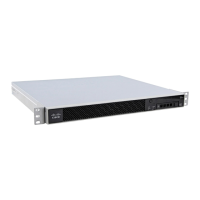1-13
Cisco ASA Series CLI Configuration Guide
Chapter 1 Configuring OSPF
Customizing OSPFv2
Configuring an OSPFv2 NSSA
The OSPFv2 implementation of an NSSA is similar to an OSPFv2 stub area. NSSA does not flood Type
5 external LSAs from the core into the area, but it can import autonomous system external routes in a
limited way within the area.
NSSA imports Type 7 autonomous system external routes within an NSSA area by redistribution. These
Type 7 LSAs are translated into Type 5 LSAs by NSSA ABRs, which are flooded throughout the whole
routing domain. Summarization and filtering are supported during the translation.
You can simplify administration if you are an ISP or a network administrator that must connect a central
site using OSPFv2 to a remote site that is using a different routing protocol with NSSA.
Before the implementation of NSSA, the connection between the corporate site border router and the
remote router could not be run as an OSPFv2 stub area because routes for the remote site could not be
redistributed into the stub area, and two routing protocols needed to be maintained. A simple protocol
such as RIP was usually run and handled the redistribution. With NSSA, you can extend OSPFv2 to
cover the remote connection by defining the area between the corporate router and the remote router as
an NSSA.
Before you use this feature, consider these guidelines:
• You can set a Type 7 default route that can be used to reach external destinations. When configured,
the router generates a Type 7 default into the NSSA or the NSSA area boundary router.
• Every router within the same area must agree that the area is NSSA; otherwise, the routers cannot
communicate with each other.
area area-id authentication
Example:
hostname(config-rtr)# area 0
authentication
Enables authentication for an OSPF area.
area area-id authentication message-digest
Example:
hostname(config-rtr)# area 0
authentication message-digest
Enables MD5 authentication for an OSPF area.
Command Purpose

